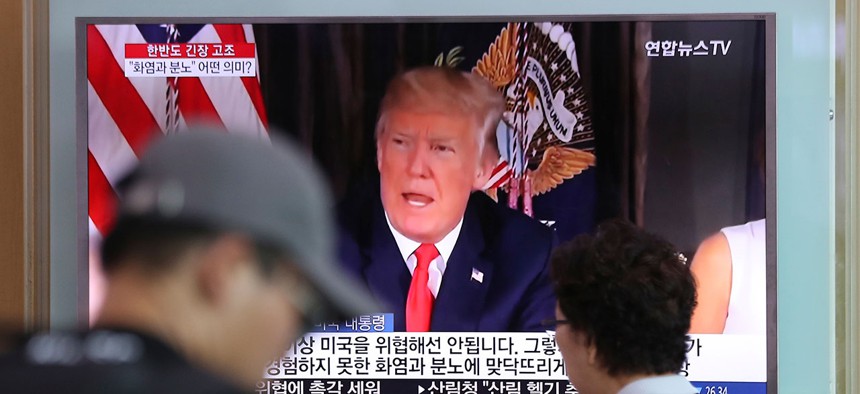What's the Logic Behind Trump's Threat to North Korea?
The president has vowed the greatest display of military power in living memory—over threats.
Members of Donald Trump’s administration have repeatedly signaled that they might be willing to use military force against North Korea—even if it inflicted on the Korean peninsula the worst human catastrophe in living memory—if it meant preventing Kim Jong Un from acquiring the capability to strike the United States with a nuclear weapon. But on Tuesday, the president himself did something different. He threatened to inflict the worst human catastrophe in living memory if North Korea were to so much as threaten the United States. Period.
“North Korea best not make any more threats to the United States,” Trump told journalists assembled at his New Jersey golf club. “They will be met with fire, fury, and frankly power, the likes of which this world has never seen before.”
The statement is stunning for a number of reasons. To begin with, Trump made it on the same day that reports emerged of a U.S. intelligence assessment suggesting that North Korea has produced a nuclear warhead small enough to be placed on a missile, and just days after North Korea tested its second intercontinental ballistic missile, or ICBM. Taken together, these data points indicate that the North Korean government has already developed—or is quite close to developing—a nuclear weapon that can hit parts of the U.S. Back in January, on Twitter, Trump said of this precise scenario: “It won’t happen!” In other words, Trump promised to rain fire and fury on North Korea just as his previous promise on North Korea has begun to ring hollow.
And even if North Korea hasn’t yet crossed Trump’s red line on obtaining a nuclear-tipped long-range missile, it will almost certainly violate the latest red line that the president has drawn. We’re talking about a North Korean government that, only yesterday, threatened to exact “thousands-fold” revenge on the United States for organizing sanctions against Pyongyang at the UN Security Council. We’re talking about a North Korean government that over the years has issued a steady volley of anti-American threats laden with the kind of bristling, bellicose language employed by Trump on Tuesday. This is the government that, long before it was testing ICBMs, was vowing to “annihilate the U.S. imperialist aggressors,” to bomb Austin, Hawaii, Washington, and Los Angeles, to attack the “boiled pumpkin” that is the United States of America. Under Kim Jong Un, North Korea has frenetically carried out all manner of non-verbal provocations as well, from menacing military parades to nuclear tests to ballistic-missile launches. Trump did not specify on Tuesday what variety of North Korean threat he had in mind.
If Trump’s statement was intended to intimidate North Korea into making concessions on its nuclear-weapons program—or to persuade China to crack down on its North Korean ally as a means of averting war in China’s neighborhood—then what happens when North Korea makes another threat against the United States and Trump doesn’t bring the fire and fury, just as he couldn’t stop the North Koreans from fitting a nuke to a missile? Will the president’s words retain any power, any credibility, to deter North Korea’s aggression and change the behavior of its allies?
But if he means it, he’s saying that threats alone justify an unprecedented display of military power—and putting an extremely high price on maintaining his credibility.




